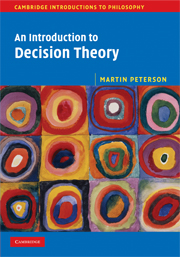Book contents
- Frontmatter
- Contents
- Preface
- 1 Introduction
- 2 The decision matrix
- 3 Decisions under ignorance
- 4 Decisions under risk
- 5 Utility
- 6 The mathematics of probability
- 7 The philosophy of probability
- 8 Why should we accept the preference axioms?
- 9 Causal vs. evidential decision theory
- 10 Bayesian vs. non-Bayesian decision theory
- 11 Game theory I: Basic concepts and zero-sum games
- 12 Game theory II: Nonzero-sum and cooperative games
- 13 Social choice theory
- 14 Overview of descriptive decision theory
- Appendix A Glossary
- Appendix B Proof of the von Neumann–Morgenstern theorem
- Further reading
- Index
12 - Game theory II: Nonzero-sum and cooperative games
- Frontmatter
- Contents
- Preface
- 1 Introduction
- 2 The decision matrix
- 3 Decisions under ignorance
- 4 Decisions under risk
- 5 Utility
- 6 The mathematics of probability
- 7 The philosophy of probability
- 8 Why should we accept the preference axioms?
- 9 Causal vs. evidential decision theory
- 10 Bayesian vs. non-Bayesian decision theory
- 11 Game theory I: Basic concepts and zero-sum games
- 12 Game theory II: Nonzero-sum and cooperative games
- 13 Social choice theory
- 14 Overview of descriptive decision theory
- Appendix A Glossary
- Appendix B Proof of the von Neumann–Morgenstern theorem
- Further reading
- Index
Summary
In the final sections of Chapter 11 we showed that all (two-person) zero-sum games can be solved by determining a set of equilibrium strategies. From a purely theoretical perspective, there is little more to say about zero-sum games. However, nonzero-sum games are more interesting, and require further attention by game theorists. This chapter gives a brief overview of what we currently know about nonzero-sum games. First, we shall give a proper introduction to the equilibrium concept tacitly taken for granted in the previous chapter. We will then go on to analyse a couple of well-known nonzero-sum games. The chapter ends with a discussion of whether game theory has any implications for ethics, biology and other subjects, which some scholars believe is the case.
The Nash equilibrium
The prisoner's dilemma is an example of a nonzero-sum game. This is because the loss or gain made by each player is not the exact opposite of that made by the other player. If we sum up the utilities in each box they do not always equal zero. In the prisoner's dilemma each prisoner will have to spend some time in prison no matter which strategy he chooses, so the total sum for both of them is always negative. To see this point more clearly, it is helpful to take a second look at the game matrix of the prisoner's dilemma (Table 12.1).
- Type
- Chapter
- Information
- An Introduction to Decision Theory , pp. 240 - 262Publisher: Cambridge University PressPrint publication year: 2009

